This website uses cookies so that we can provide you with the best user experience possible. Cookie information is stored in your browser and performs functions such as recognising you when you return to our website and helping our team to understand which sections of the website you find most interesting and useful.
Interview: Celebrity photographer Andy Gotts on the Oscars, his new exhibition and the stories behind his portraits
By Shivani Dubey | 28 February 2024 | Arts, Culture
From Robert De Niro’s impression-ception to Heath Ledger throwing paper balls at Matt Damon, Tempus sits down with Andy Gotts for an in-depth look into the life of a celebrity photographer — and the anecdotes he’s accumulated over the years
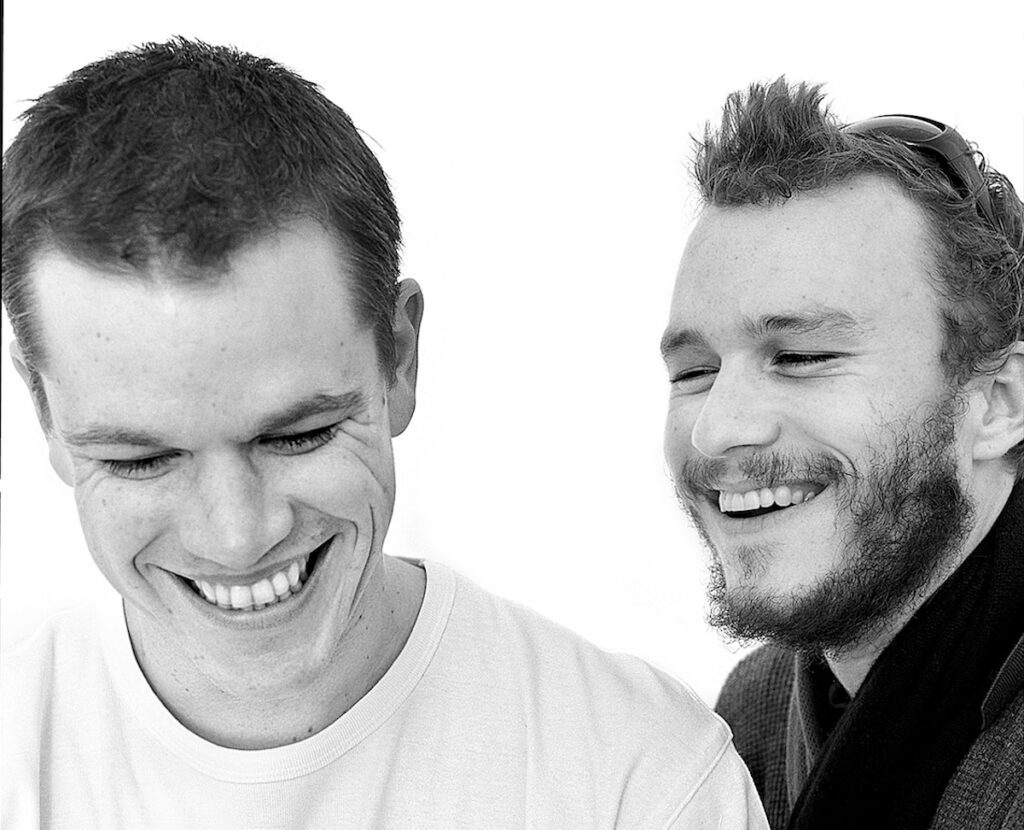
They say every photo tells a story. That is certainly true in the case of celebrity photographer Andy Gotts. Over a 30-year career Andy has photographed basically every celebrity under the sun. From capturing Robert De Niro in an Al Pacino impression-ception to being in cahoots with Meryl Streep to capture a shot exactly the way he wanted to — despite her team’s reluctance, Andy has a treasure trove of stories to accompany every picture he takes.
We caught up at 45 Park Lane in London, where he has handpicked some of his favourite pictures to display at his latest exhibition, And the Winner Is…. And with a welcoming smile and a genuine reverence for the celebrities he has photographed, Andy walked us through the most cherished portraits of his career.
From heartfelt stories of capturing the final pictures of Robin Williams and Tony Curtis to making Kate Winslet laugh at his collection of crude jokes, Andy tells us the stories behind his portraits, who he hopes to see win big at the Oscars this year and the secret behind a good picture.
Andy, what inspired this exhibition?
I think it’s a few things. I’ve been a photographer for celebrities for 34 years. And I’m a movie buff — I love movies a lot. And so when you shoot people like Robert De Niro, Al Pacino, Ian McKellen or Anthony Hopkins; having them in one show by one artist is quite rare. You only see a collection of really big names in a collaborative exhibition.
And I’m lucky that in the 34 years of my career, my only commissions have been famous people, and I’ve never deviated from it. These pictures are chosen because they are people that I became friends with. Or pictures that I feel are timeless for me. They are my icons.
You chose to display this exhibition at 45 Park Lane rather than in the white space of a gallery. Why?
I’ve wanted to do exhibitions in my home city [London] for a long time. And I have done proper exhibition galleries that promote my work. They’re big and clinical — it’s very formal. I think it seems better when my work is displayed in an environment that’s more friendly, where you can sit here and have a drink.
I think that’s nicer than walking around being force fed hors d’oeuvres, and you’re made to stand and look. I don’t think people even look at the pictures on opening night — they’re talking or mingling. This kind of environment is more relaxed, because as you sit here having a conversation, your eyes wander. I wanted it to be an immersive experience rather than a clinical, formal thing.
Is there a prompt you give to result in the expressions captured in your portraits?
I don’t think there’s a prompt. I go to a photoshoot with an idea. It can be a good look or a good feeling, and we have a conversation. Honestly, in the over-7,000 photoshoots that I’ve done, something better always happens when it is not scripted or organised.
When you only photograph famous people, they are automatically programmed — they know their angles, they know how they look good. And they come to every photoshoot wanting to pull those faces. So it’s my job to make them not do that.
We set up a chat. It can be thoughtful, playful or argumentative. I can then take how they’re being, and then incorporate that in the shoots. I try not to direct them. I don’t say ‘be funny, be happy’, or anything like that. We have a conversation while I’m behind the camera and then something clicks.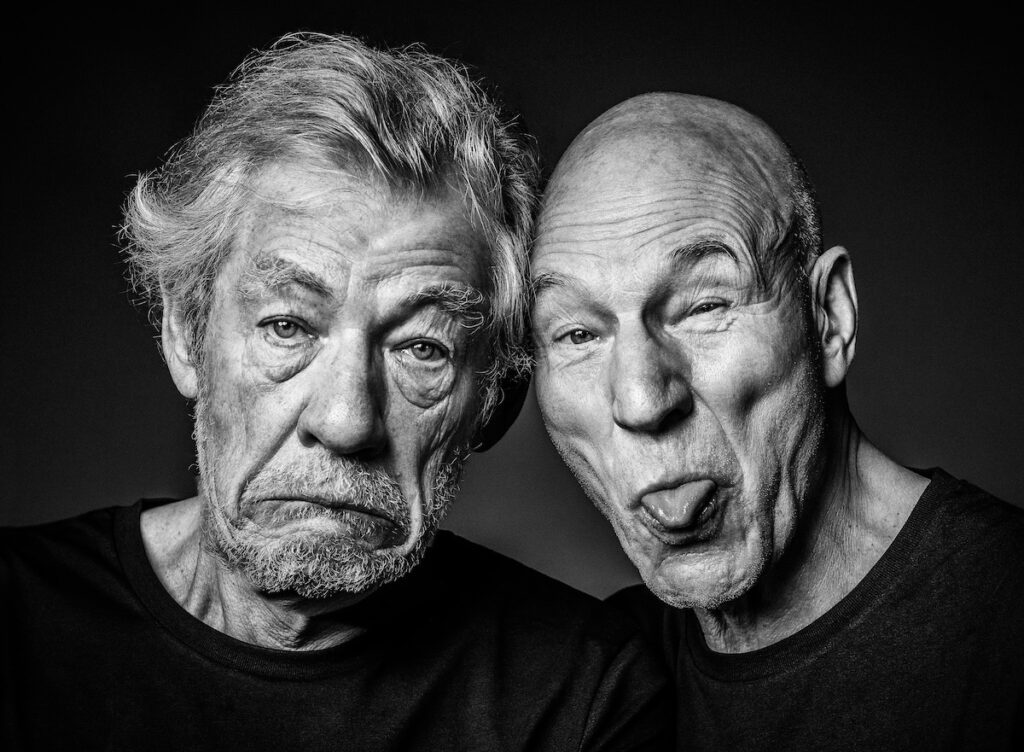 What is the secret to a great portrait? How much of it is the relationship between you and your subject?
What is the secret to a great portrait? How much of it is the relationship between you and your subject?
I do think you need to have a conversation with the person before shooting. I think knowing each other as people, that has to be established. So we get to know each other very briefly over half an hour. And it gives a sense of comfort. They then realise my shoots are not a formal affair.
I think for a good shot, you need to be armed with three things: a crude joke, alcohol (everyone loves a glass of champagne) and quickness. I think photography is a nice conversation, where now and again you hear a click, and that’s how I get my shots. I can easily craft a moment with conversation, to make them have a feeling.
For example, there’s a picture of [All of us Strangers star] Andrew Scott where we’re talking about how good an actor he is. And I asked him if he can cry on cue. He says, ‘Of course I can’. The resulting picture was with a tear down his cheek. There are things you can’t pre-plan or direct, it just happens in the moment.
Your career spans more than 30 years. Is there a particular portrait or photoshoot that holds special meaning for you?
I’d say the picture, or actor I’ve shot, that will never be eclipsed is my portrait of Tony Curtis. To me, he is one of the biggest movie stars of all time. I had been trying to shoot a portrait of him for nine years — and the answer from his management was always either that he was ill or busy.
One day, I was in Los Angeles shooting Kirk Douglas, and thought I’d give Tony another go but got the same answer from his management. So I googled Tony Curtis and found out that his wife owns a horse sanctuary in Las Vegas. I called them up and his wife, Jill Curtis, answered the phone, and I told her that I was a photographer from London and that I’d been trying to photograph her husband for nine years. She asks Tony if he’d like to do a photoshoot and tells me to come to their house in Vegas the next day.
That evening, I got a call from Tony Curtis himself, saying he doesn’t feel well but will commit to a photoshoot the next day as promised — but he had one request: “Can you make me look iconic one more time?” His nickname had been the American Prince, so I decided to paint the flag of America on his face and take the portrait.
The next day, I went over to his house for the shoot and we ended up talking for hours and I listened to his stories about the Rat Pack, [Frank] Sinatra, the mafia in Hollywood, Elvis [Presley] and so much more. The next day, after I landed back in London, I found out Tony had collapsed and was in the hospital. His wife emailed me asking if I’d send over the photo I took of him. Jill called the next day, saying Tony thought that was the best picture of him ever taken. He died that afternoon. So I think that moment will be hard to beat, for me.
Do you remember your first photoshoot? Who was it?
Stephen Fry. I was 19 years old and a photography student at university. Stephen, who is from Norfolk, was a megastar at the time. He came to my college to give a talk and hand out the diplomas; I knew he’d be in the arts block so I set up my camera equipment next door.
His talk lasted for hours and, during the Q&A portion, I asked him if he’d be okay with me taking a quick photo of him. He loved it, and asked me to make a template to put on his mantlepiece. Kenneth Branagh went over to his place for lunch, noticed that photo, and contacted me to take a picture of him.
I went over to his home in London to shoot him and [Kenneth’s then-wife, actress] Emma Thompson. When I got there, I was lost. So this man came out of his house and asked me what I’m looking for. I explained the situation and he said, “ You can park here as long as you come and take a picture of me after.” The man was Derek Jacobi. And that’s how my career started. It was my very own version of ‘Six Degrees of Kevin Bacon’. 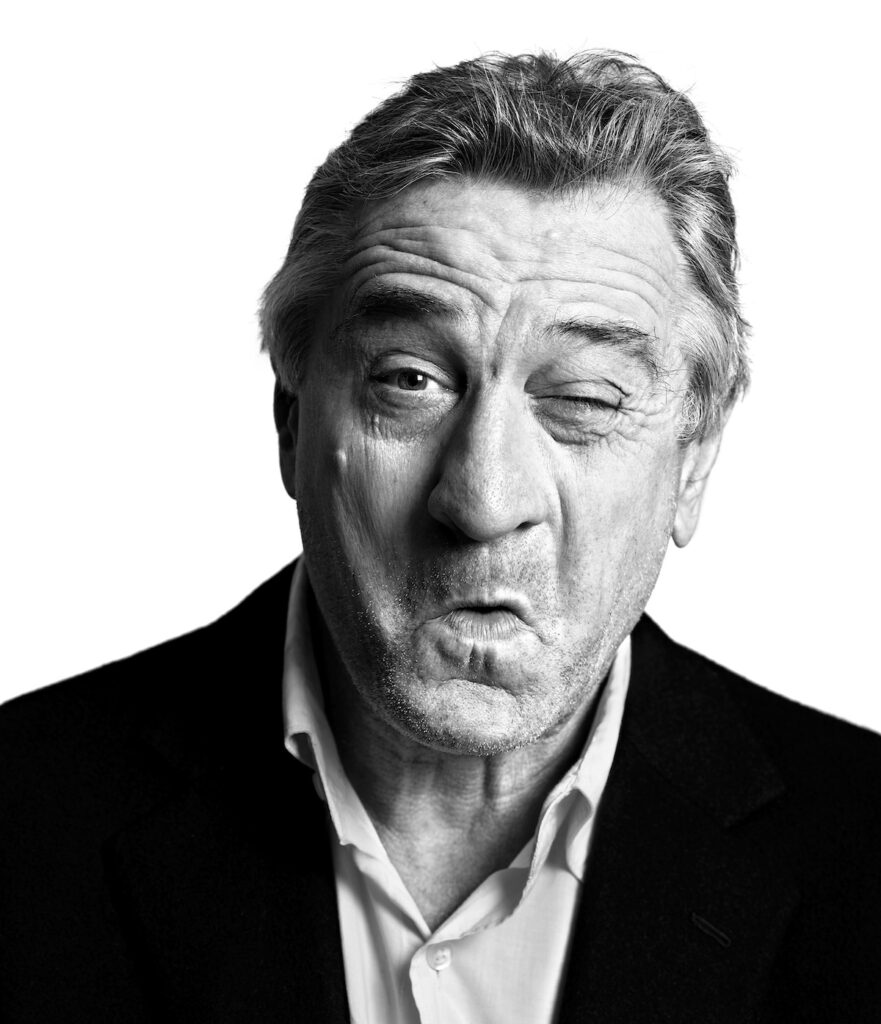 We’d love to know more about the stories behind some of the portraits on display in this exhibition. Let’s start with the photo of Robert De Niro. How did that come about?
We’d love to know more about the stories behind some of the portraits on display in this exhibition. Let’s start with the photo of Robert De Niro. How did that come about?
That’s a lovely picture. At the very end of my shoots, I do a contact sheet, which is nine shots in one picture, and I get the celebrities to do whatever they want for those nine shots. We started, and when I got to shot number five, there was a knock on the door with [Robert’s] coffee order.
Before we resumed, I asked him, “Do you ever get upset when people do that impression of you in Taxi Driver?”. He turns to me and goes, “Have you seen [Al] Pacino do that impression of me?” So that shot is Robert `de Niro doing an impression of Al Pacino doing an impression of De Niro in Taxi Driver. I love that photo because you never see him be silly like that.
Matt Damon and Heath Ledger?
Matt Damon was in the Bourne movies at the time and he was [also] filming The Brothers Grimm with Heath Ledger in Prague. I told him I wanted a moody, gritty picture of him, kind of a Jason Bourne-adjacent look. As we were shooting, we heard a bang outside the door. Turns out, it was Heath Ledger falling over a makeup trolley outside the door. He was embarrassed, so came into our room to compose himself and learned about what we were doing.
We start shooting again, and suddenly Heath is throwing wet paper towels at Matt’s head, causing them to start laughing. I asked Heath to just join the shoot, and shot an entire reel of them together. When I flew back home, the reel got lodged in my camera bag and I completely forgot about it. Then Heath passed away a few years later and I found the forgotten reel of Matt and Heath. It was quite an emotional thing, because [Heath had] just passed away and [the photos captured] a beautiful moment in time. That’s how these photos came about.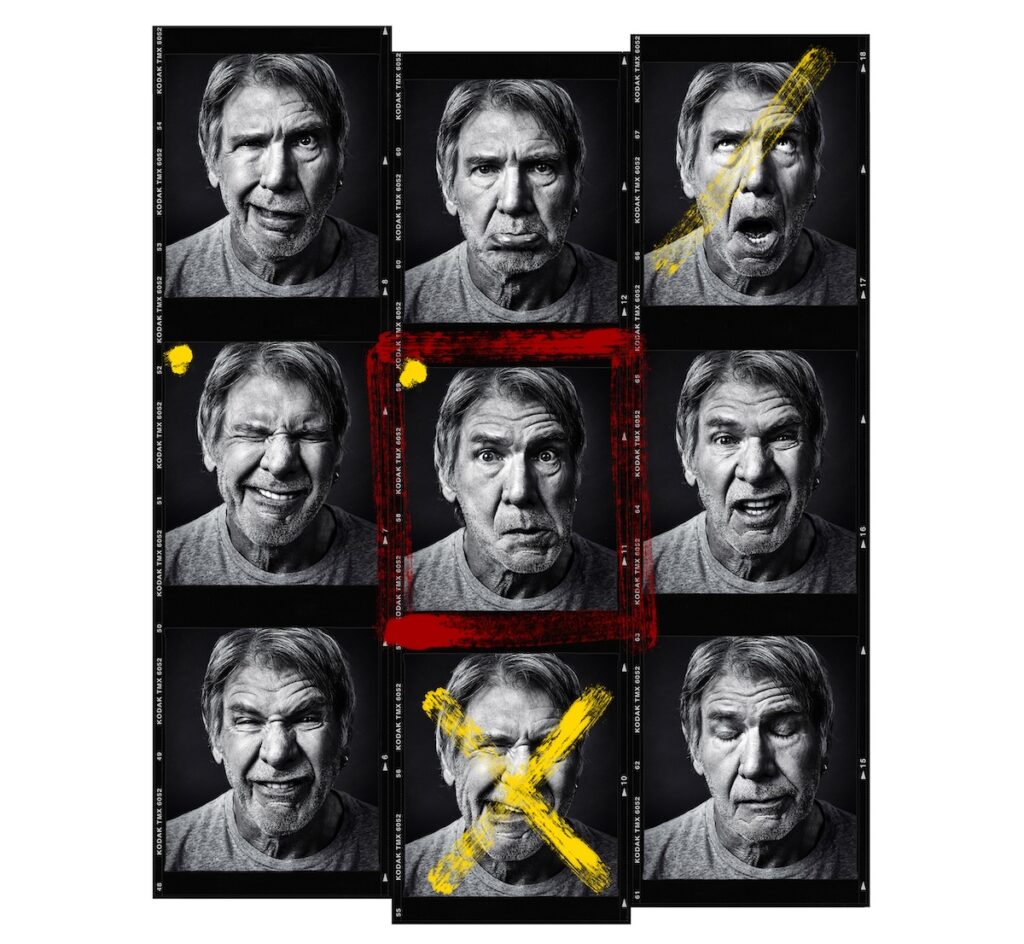 Can you talk to me about the picture of Harrison Ford?
Can you talk to me about the picture of Harrison Ford?
That was shot in his house in Mayfair [London] when he was filming Star Wars: The Force Awakens. Everyone I knew always said Harrison’s hard work — he hates interviews, hates publicity, hates photoshoots — and just didn’t like that part of the industry, so I was surprised he agreed to the photoshoot.
He was very uncooperative in conversation [at first]. But I knew [Harrison] was really into old aircraft and aviation, and it was the anniversary of the Second World War Dambusters Raid. I kept elaborating on the story of the raid, and Harrison looked at me with a smile and became really relaxed.
I asked him when was the last time he’d ever been silly in photoshoots, and he replied that in 35 years, no one had asked him to do that. We ended up taking about 30 shots of him just being silly.
Finally, what is the story behind the picture of Meryl Streep?
She was doing press for The Iron Lady. I wanted it to look different from all the other pictures of her, but when her makeup artist came in and saw the setup, he wasn’t pleased. He said that Miss Streep is never lit this way and that I’d have to change it or they wouldn’t go through with it. I took some pictures with the basic lighting, but I knew the pictures all looked the same. So I decided to be naughty. As soon as [the makeup artist] left the room I changed the lighting.
Meryl started clapping, saying: “Good for you!”. Then I took the pictures I wanted to take. When I sent her the pictures later, the ones taken with my lighting were her favourites. In the picture, she’s got this little smile because she knows I’ve been naughty and she’s joining in the fun of it. 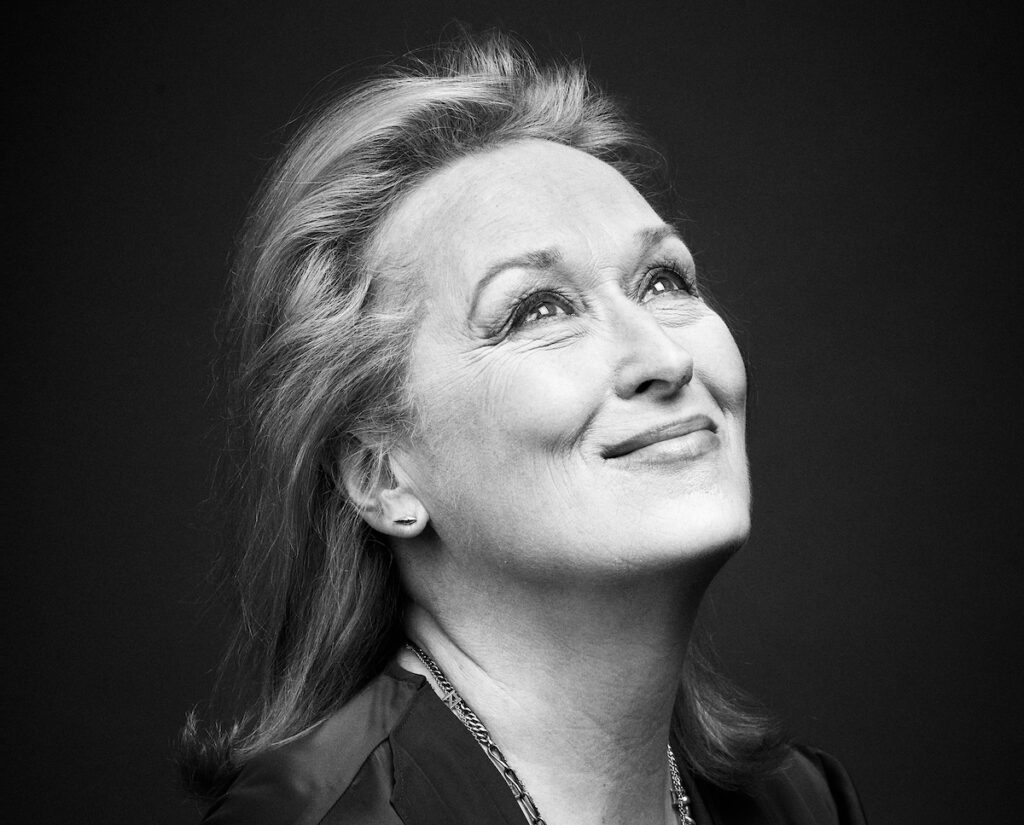 Of the films nominated for Best Picture at the Oscars this year, which one would you like to see win? Any actors you hope to see lift the trophy as well?
Of the films nominated for Best Picture at the Oscars this year, which one would you like to see win? Any actors you hope to see lift the trophy as well?
I love 80s movies, and there is one movie this year that reminds me of an 80s movie and that is The Holdovers. And so for no other reason, I’d say this because the film is like a throwback for me. One person I’d love to see win in the Best Supporting Actress category is Jodie Foster. Her or Annette Bening. And Paul [Giamatti for The Holdovers], I think this could be his year.
Is there an actor you’d love to photograph?
There’s one actor I’d love to photograph, but never will, is Gene Hackman. I grew up seeing him as Lex Luthor in Superman and Popeye Doyle in The French Connection. But then he retired from public life. He is now a semi pro golfer in New Mexico.
Another person I’d beeline to would be Robert Redford. My shot of Paul Newman is one of his last shots ever taken, so if I ever get Redford, I’d shoot it the same way. If you put those pictures side by side in a magazine, it would look like the last pictures of Butch Cassidy and the Sundance Kid together. I think that would be very cool.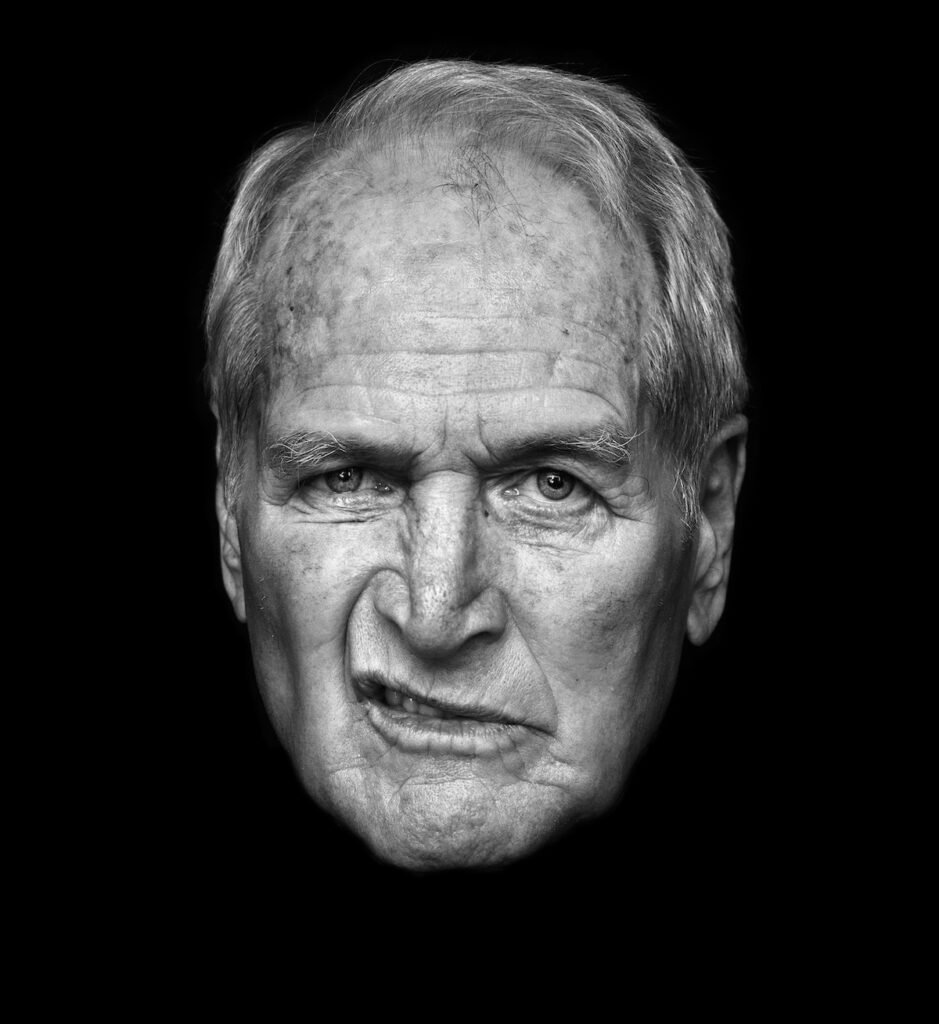 What do you hope people take away from this exhibition?
What do you hope people take away from this exhibition?
I hope people can walk away understanding that celebrity portraiture doesn’t have to be perfect. No face is perfect. A human face, no matter how famous it is, is warts-and-all. Like the picture of Scarlett Johansson. She’s got pimples on her forehead. I told her I wouldn’t edit them out and she said: “Good — I want people to see my flaws”. The pictures you see on magazine covers of famous people aren’t reality. These are the real faces of real actors, and I want people to walk away thinking these faces are beautiful.
To read more behind the scenes stories of Andy’s portraits, subscribe to our newsletter, the Tempus Edit, here. For more interviews with Tempus, click here.







